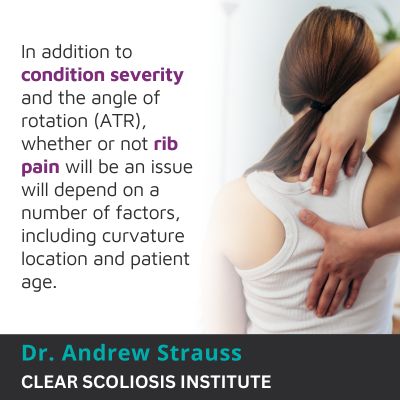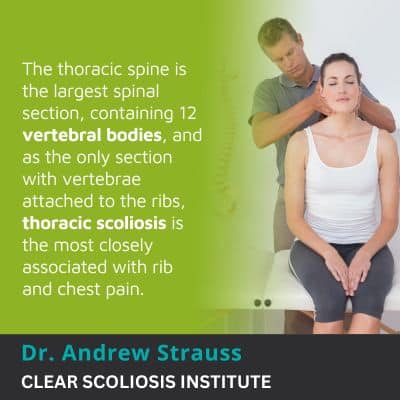
Scoliosis is a highly-prevalent structural spinal condition that we’re still learning about. Scoliosis affects all ages, and the condition’s effects can differ based on a number of variables, including patient age; when it comes to rib pain, this is more common in adults and/or in severe cases with a lot of rotation.
The effects of scoliosis can be widespread and felt throughout the body, and when it comes to the chest and ribs, the postural changes caused by scoliosis can include the development of an arch in the rib cage, capable of causing rib and chest pain.
Scoliosis is a complex condition, so let’s discuss the variables that shape a condition’s effects.
Scoliosis involves the development of an unnatural side-to-side spinal curve that also twists, and as a progressive condition, most cases of scoliosis will get worse.
Scoliosis progressing means the size of the unnatural spinal curve is increasing, along with the spine’s rotation, and as this occurs, the condition’s uneven forces increase, and this is when condition effects tend to become more overt.
The body is a symmetrical structure, and as scoliosis develops and progresses, a main effect is a disruption to the body’s overall symmetry, and this is because the development of a scoliotic curve introduces uneven forces to the spine and body.
As scoliosis progresses, it’s becoming more severe, and this makes it more complex to treat, hence the benefit of early detection and intervention.
There are never treatment guarantees, but cases that are diagnosed early and responded to with a proactive treatment approach do tend to respond more positively to treatment.
When it comes to condition effects, condition severity is significant.
So as a progressive condition, the nature of scoliosis is for its severity to change over time, but how is condition severity determined?
When scoliosis is being diagnosed, an important step is further classifying conditions based on specific patient and condition variables that differ from patient to patient; these variables inform the customization of treatment plans.
Condition severity shapes treatment plans and is determined by a patient’s Cobb angle measurement, determined during X-ray.
 In order to diagnose scoliosis, an X-ray is needed to see what’s really happening to the spine, its surroundings, to confirm there is rotation present, and to determine condition severity based on the Cobb angle.
In order to diagnose scoliosis, an X-ray is needed to see what’s really happening to the spine, its surroundings, to confirm there is rotation present, and to determine condition severity based on the Cobb angle.
Cobb angle is measured by drawing lines from the tops and bottoms of vertebrae at the curve’s apex; these will be the most unnaturally tilted, and the resulting angle is measured in degrees.
In a healthy spine, its vertebrae are aligned, but when an unhealthy spinal curve has developed, certain vertebrae have become unnaturally tilted, and this shifts their position out of alignment with the rest of the spine.
A misaligned spine doesn’t just affect the spine, but also its surrounding muscles and nerves that are being exposed to uneven forces, and the entire body.
A spine that has its healthy curves in place is stronger, more flexible, and better able to handle stress from daily life and activities: absorbing and distributing mechanical stress from movement and impact evenly along the spine.
The higher a patient’s Cobb angle, the more misaligned the spine is, the more severe the condition is, and the more likely it is that its effects will be noticeable:
And remember, as a progressive condition, where a condition’s effects are at the time of diagnosis doesn’t mean that’s where they will stay; proactive treatment is needed to counteract progression, increasing severity, and effects.
As the brain and spinal cord work together to facilitate brain-body communication as the central nervous system, spinal conditions like scoliosis can cause a wide range of effects that should be taken seriously.
In addition to condition severity and the angle of rotation (ATR), whether or not rib pain will be an issue will depend on a number of factors, including curvature location and patient age.
There are three main sections of the spine, known as the cervical spine (neck), the thoracic spine (middle/upper back), and the lumbar spine (lower back).
As it’s generally the area of the body located closest to the scoliotic spinal section that’s going to experience most of its direct effects, curvature location is important.
The thoracic spine is the largest spinal section, containing 12 vertebral bodies, and as the only section with vertebrae attached to the ribs, thoracic scoliosis is the most closely associated with rib and chest pain.
As thoracic scoliosis progresses, the unnaturally-curved and rotating spine pulls on the rib cage where it attaches to the thoracic vertebrae, and this disrupts its position and can cause the development of a rib cage arch.
As the spine’s rotation makes scoliosis a 3-dimensional condition, in addition to the spine becoming more unnaturally bent to the side, it also becomes more twisted, further disrupting the position of the rib cage.
As rotation increases, it can cause the ribs on one side to protrude more than the other, and this is the development of a rib cage arch.
In children, the condition’s most-noticeable effects involve postural changes:
Additional effects that increase alongside postural changes include disruptions to gait, balance, and coordination.
So as scoliosis disrupts the position of the rib cage, causing the development of a rib cage arch, how does that postural change feel? Is a rib cage arch painful?

Scoliosis is most often diagnosed in children, but it affects all ages, and once skeletal maturity has been reached, scoliosis becomes a compressive condition.
Compression means uneven pressure, and compression of the spine and its surroundings (muscles and nerves) is the main cause of scoliosis pain.
So in young patients who are still growing, their spines are constantly being lengthened, and this counteracts the compressive force of the scoliotic curve, which is why back and rib pain isn’t considered a common effect of childhood scoliosis, but it is in adult scoliosis.
In fact, it’s back pain and pain radiating into the extremities due to nerve compression that brings most adults in for a diagnosis and treatment, so rib and chest pain is more likely to be an issue in adult patients, for whom the condition is compressive, than in young patients who are still growing.
Rib pain is also more likely in conditions that are severe and have a lot of rotation, and/or in cases that are left untreated, or not treated proactively.
So can scoliosis cause rib pain: yes, it can, but isn’t guaranteed to do so, and there are a number of factors that shape the types of scoliosis symptoms a patient experiences.
What one patient experiences isn’t a reliable indicator of what others will face.
Treatment plans need to be customized around key variables: condition severity, type, curvature location, and patient age.
Scoliosis rib pain is most common in cases of adult thoracic scoliosis and/or in cases that are particularly severe, have a lot of rotation, or are left untreated.
Conditions left untreated can continue to progress and cause complications; if a rib cage arch is not addressed, for example, it’s likely to get worse, and while not a common complication, breathing issues can develop as the changing position of the rib cage can mean less room for the lungs to function optimally within.
While lung impairment is more common in severe cases and/or is often only noticeable to professional athletes who place higher-than-average demands on their respiratory systems, it is a potential complication associated with the development of a rib cage arch that’s not addressed with treatment: another reason to treat scoliosis proactively.
Here at the CLEAR Scoliosis Institute, patients are treated with a modern conservative treatment approach that proactively works towards preventing progression, increasing condition severity and effects, and the need for more-invasive surgical treatment in the future.

CLEAR provides a unique and innovative way of understanding scoliosis. Sign up to receive facts and information you won’t find anywhere else.
